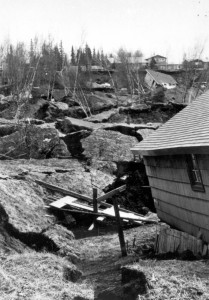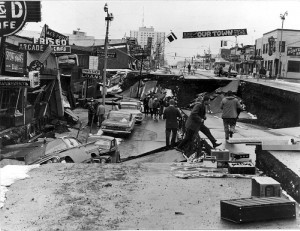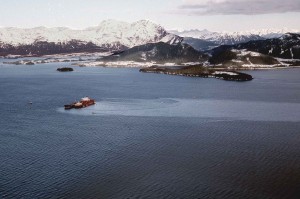“Good” Friday?
Good Friday – the Friday before Easter, has not been so good for the residents (human and otherwise) around Prince William Sound, Alaska. Two disasters, 25 years apart, continue to leave their mark on the area.
The town of Portage on the Turnagain Arm was lowered to below sea level, and so had to be permanently abandoned. The village of Chenega was destroyed by the tsunami and 23 of the 68 inhabitants killed. The downtown area of Anchorage experienced heavy damage. Seeing the second story of some buildings at street level makes it a wonder to me that more people weren’t killed. The effects of the earthquake were felt worldwide: “Seiches, a sort of sloshing of water back and forth in a small body of water like a boat harbor or swimming pool, were observed as far away as Louisiana where a number of fishing boats were sunk. Oscillations in the height of water in wells were reported from as far away as South Africa.” [1] An asphalt storage plant near Valdez was destroyed, spilling an unknown quantity of asphalt into Prince William Sound. With the area inundated with relief efforts pertaining to the earthquake and tsunami, no particular clean-up effort was attempted for this spill. Today, remains of the asphalt spill are mixed with remains of another spill [3], which brings us to the second Good Friday disaster.
On March 24, 1989, the supertanker Exxon Valdez was navigating Prince William Sound (outside of normal shipping lanes to avoid ice) when it struck Bligh Reef and spilled 11 million of its’ 53 million gallons of toxic, unrefined crude oil into the sound and fouling 1,100 miles of coastline. [4] This spill was particularly egregious because it happened in a wild and beautiful setting and because of the culpability of the captain, third mate and Exxon itself in causing a completely avoidable disaster. In the aftermath of the spill, Exxon did not take the high road, dragging its’ feet in the cleanup and contending and delaying any payout for punitive damages, claiming they were not appropriate in an “accident”. More than 20 years later, the effects of the spill are still being felt in the area, with some wildlife species still not having recovered. [5]
Vox’s Take: Sadly, the infamous Exxon Valdez Spill is dwarfed by the Deepwater Horizon Spill of 2010, which spewed an estimated 218 million gallons of crude oil into the Gulf of Mexico. [6] Given the Exxon example, and the ability of huge corporations with their teams of lawyers to avoid accountability for their misdeeds, its seems unlikely that British Petroleum (BP) will end up paying for more than a small fraction of the damages.
Sources:
[1] The Great Alaska Earthquake of 1964, Alaska Earthquake Information Center
[2] The Great Alaskan Earthquake & Tsunamis of 1964, by Thomas J. Sokolowski, West Coast & Alaska Tsunami Warning Center, Palmer Alaska
[3] The Good Friday Catastrophes in Prince William Sound, Alaska, U.S. Geological Survey Energy Resource Surveys Program
[4] Exxon Valdez oil spill, The Encyclopedia of Earth
[5] A Report on the 20th Anniversary of the Good Friday Spill from the Exxon Valdez Oil Spill Trustee Council (EVOSTC), Information About Alaska
[6] Deepwater Horizon oil spill, The Encyclopedia of Earth


